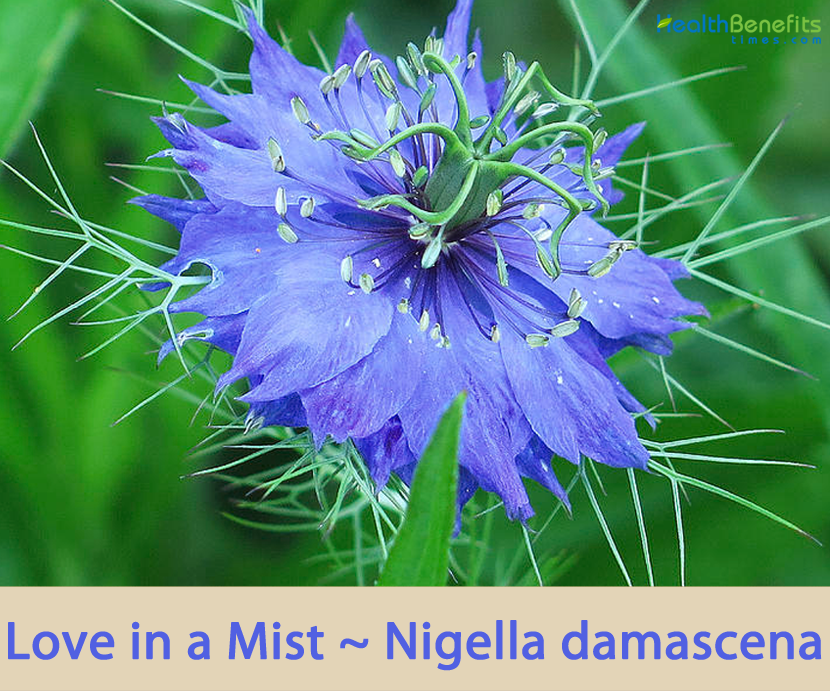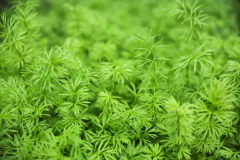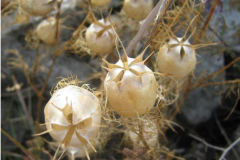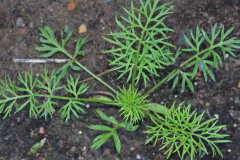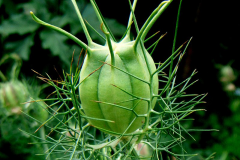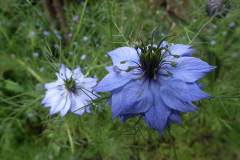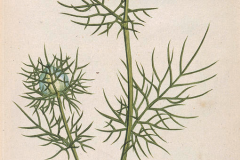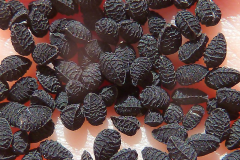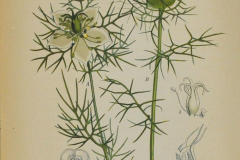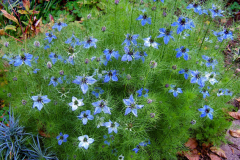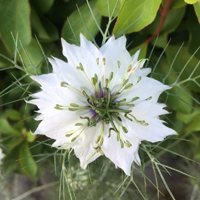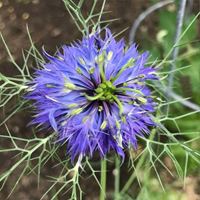| Love in a Mist Quick Facts | |
|---|---|
| Name: | Love in a Mist |
| Scientific Name: | Nigella damascena |
| Origin | Southern Europe (but adventive in more northern countries of Europe), north Africa and southwest Asia |
| Colors | Green with purple or bronze stripes becoming brown as they mature |
| Shapes | Attractive, swollen balloon-shaped seedpod fused at the base to form a capsule, about 1.5- 2 cm long |
| Taste | Intense, nutmeg-like flavor |
| Health benefits | Support for high temperatures, regulation of menstruation, catarrhal affections, flu, asthma, upper-respiratory conditions, gastrointestinal parasites, diabetes, cholesterol and reduce pain |
| Name | Love in a Mist |
|---|---|
| Scientific Name | Nigella damascena |
| Native | Southern Europe (but adventive in more northern countries of Europe), north Africa and southwest Asia, where it is found on neglected, damp patches of land |
| Common Names | Love-in-a-mist, devil in the bush, bird’s nest, blue crown, blue spider flower, chase the devil, garden fennel, jack in prison, jack in the green, Katherine’s flower, kiss me twice before I rise, lady in the bower, love in a puzzle, love in a tangle, St Catherine’s flower, nigella, ragged lady, Spanish fennel flower, Wild fennel, Damascus hellebore |
| Name in Other Languages | Afrikaans: Liefde-in-‘n-mis, Juffertijie-in-groen Albanian: Love-in-a-mjegull, nigela e Damaskut, nigelë Amharic: Fik’iri-wisit’i-ch’igagi (ፍቅር-ውስጥ-ጭጋግ) Arabic: Alhabu fi aldabab (الحب في الضباب) Aragonese: Arañuela Armenian: Ser-marrakhugh (սեր-մառախուղ) Azerbaijani: eşq içində-eşqdə Basque: Katu bixarra Bengali: Prēma-ina-ē-kuẏāśā (প্রেম-ইন-এ-কুয়াশা) Bulgarian: Lyubov-v-a-mŭgla (любов-в-а-мъгла), damaska chelebitka (дамаска челебитка) Burmese: Aahkyit -In-a- a hkoe aangwae (အချစ် -In-a- အခိုးအငွေ့) Catalan: Aranya, Barba d’ermità, Ermità, Estel, Estela-mare, Estrella de camp, Flor d’aranya, Herba de capseta, Llanternes Chinese: Míwù zhōng (迷霧中), Hei zhong cao (黑 种草) Croatian: Ljubav-u-magla, damaščanska crnjika Czech: Láska v mlze, černucha damašská Danish: Kærlighed-in-a-tåge, Jomfruen i det grønne Dutch: Liefde-in-een-mist, Juffertje in ‘t-groen, Juffertje-in-het-groen English: Devil in a bush, Love-in-a-mist, Jack-in-the-green, Wild fennel, Damascus hellebore Esperanto: Amo-en-nebulo Estonian: Armastus-udu-udu Filipino: Pag-ibig-in-a-mist, tarhaneito Finnish: Rakkaus-in-a-sumu, Neidonkukka, Tarhaneito French: Amour dans la brume, Cheveux de Vénus, Nigelle de Damas, barbe de capuchin, barbiche, patte d’araignée Galician: Luceiros Georgian: Siq’varuli-menji (სიყვარული-მენჯი) German: Liebe im Nebel, Braut im Haar, Damaszener Schwarzkümmel, Gretchen im Bush, Gretel im Busch, Jungfer im Grünen, Jungfrau im Grün, Türkischer Schwarzkümmel, Braut in Haaren, damaszener Schwarzkümmel Greek: agápi se mia omíchli (αγάπη σε μια ομίχλη), koinó mavrokoúki (κοινό μαυροκούκι) Gujarati: Prēma-māṁ-ēka-jhākaḷa (પ્રેમ-માં-એક-ઝાકળ) Hausa: So-in-a-hazo Hebrew: Ketzach dammaska’I, אהבה בתוך ערפל, קֶצַח דַּמַּשְׂקָאִי Hindi: Pyaar mein ek-dhundh (प्यार में एक-धुंध) Hungarian: Love-in-a-köd, Kerti kandilla, borzaskata, vetési katicavirág Icelandic: Ast-í-a-mist Indonesian: Cinta-dalam-kabut Irish: Grá-i-ceo Italian: Love-in-a-mist, Anigella, damigella, Capelli di venere, Damigella scapigliata, Erba bozzolina, Nigella damascena, Melanzio, Scapigilate, nigella di Damasco Japanese: Kiri no naka no ai (霧の中の愛), Kuro tanetsou (ク ロタネソウ ), nigera (ニゲラ) Javanese: Tresno-in-a-mist Kannada: Prīti-ondu-man̄ju (ಪ್ರೀತಿ-ಒಂದು-ಮಂಜು) Kazakh: maxabbat adaswı (махаббат адасуы) Korean: Angaee salang (안개에 사랑), heug jongcho (흑 종초), Huk chong cho Kurdish: Hezkirina-di-mist Lao: Love-in-a-mist Latin: Amor-in-a-caligo Latvian: Mīlestība-miglā Lithuanian: Meilė-rūke, Darželinė juodgrūdė Macedonian: Loveubov-vo-magla (loveубов-во-магла) Malagasy: Ny fitiavana-in-a-zavona Malay: Cinta dalam kabus Malayalam: Snēhaṁ-oru-mūṭalmaññ (സ്നേഹം-ഒരു-മൂടൽമഞ്ഞ്) Maltese: Love-in-a-mist Marathi: Prem-in-e-mist (प्रेम-इन-ए-मिस्ट) Mongolian: Khairyn manan (хайрын манан) Nepali: Love-in-a-mist Norwegian: Love-in-a-tåke, Jomfruen i det grønne Occitan: Pate d’aranha Oriya: ପ୍ରେମ-ଇନ୍-କୁହୁଡି | Pashto: په مینه کې-ګناه Persian: عشق در یک غبار Polish: Miłość we mgle, Czarnuszka damasceñsca Portuguese: Amor-em-uma-névoa, Barbas-de-velho, Cabelo-de-vênus, Dama-entre-verdes, Nigela-dos-jardins, Nigela-de-Damasco, Damas-entre-verde, Nigela, damas-do-bosque Punjabi: Lava-ina-ē-misaṭa (ਲਵ-ਇਨ-ਏ-ਮਿਸਟ) Romanian: Dragoste-in-a-ceață, chica voinicului Russian: Nigella (нигелла), Chernushka damasskaia (Чернушка дамасская), devitsa v zeleni (девица в зелени) Serbian: Ljubav u magli (љубав у магли), mačkov brk (мачков брк), čupava kata (чупава ката), čupava crnika (чупава црника) Sindhi: پيار-ان-ڪوڙ Sinhala: Mīdumaka ādaraya (මීදුමක ආදරය) Slovak: Cernuška damascénska, čiernucha damašska Slovene: Vzhodna črnika, Slovenian: Ljubezen-v-megli Spanish: Amor en la niebla, Ajeluz, Araña, Arañuela, Nequilla de Damasco, Cabellos de Venus, Barbas-de-velho, Damas-entre-verde, ajenuz de jardín, arañas, neguilla Sudanese: Cinta-di-a-halimun Swedish: Love-in-a-mist, Jungfrun i det gröna Tajik: Işqi oşiqona (ишқи ошиқона) Tamil: Kātal-oru-mūṭupaṉi (காதல்-ஒரு-மூடுபனி) Telugu: Prēma-lō- a- misṭ (ప్రేమ-లో- a- మిస్ట్) Thai: Khwām rạk nı-a-h̄mxk (ความรักใน-a-หมอก) Turkish: Cörekotu, şam çörekotu Ukrainian: Zakokhanyy v tuman (закоханий в туман), zakokhanyy v tuman (чорнушка дамаська) Urdu: محبت میں ایک دوبی Uzbek: Tumanli sevgi Vietnamese: Tình yêu trong sương mù Welsh: Cariad-mewn-niwl, Glas y Niwl Zulu: Uthando-in-a-mist |
| Plant Growth Habit | Upright growing, small to medium sized, annual garden flowering plant |
| Growing Climates | Stony, sunny positions, dump sites, waste places, fields, meadows, roadsides and in rocky ground |
| Soil | Prefers moist sandy soil, though it doesn’t like to sit in wet soil and does best with a neutral soil pH. Love-in-a-mist can tolerate somewhat dry conditions, as well as other types of soil, including loam, clay-loam, and gravelly soil |
| Plant Size | 15 to 24 inches (28-61 cm.) in height and up to a foot (31 cm.) in width |
| Stem | Stems erect, slender, 10-75 cm, glabrous |
| Leaf | Leaves are primary or secondary pinnately lobed and finely lobed. The lower stem leaves are stalked, 2-3 mm long, and the upper leaves are sessile |
| Flowering season | July to October |
| Flower | Flowers have a single branch-top and a 5-calyx, usually bright blue to very pale blue but some may be white, pink, or lavender, petal-like, 8-12 mm long, elliptically ovate, and gradually narrow into claws at the base. The upper lip is shorter than the lower lip, its apex gradually narrows into a linear shape, the lower lip is 2 deep cleft, the middle of the wider, apex and middle of the tuberous process |
| Fruit Shape & Size | Attractive, swollen balloon-shaped seedpod fused at the base to form a capsule (actually an inflated capsule composed of 5 fused true seedpods), about 1.5- 2 cm long |
| Fruit Color | Green with purple or bronze stripes becoming brown as they mature |
| Taste | Intense, nutmeg-like flavor |
| Plant Parts Used | Flowers, Leaves |
| Propagation | By seed |
| Season | August to October |
| Suggested Use |
|
Plant Description
Love in a Mist is an upright growing, small to medium sized, annual garden flowering plant that normally grows about 15 to 24 inches (28-61 cm.) in height and up to a foot (31 cm.) in width. The plant is found growing in stony, sunny positions, dump sites, waste places, fields, meadows, roadsides and in rocky ground. The plant prefers moist sandy soil, though it doesn’t like to sit in wet soil and does best with a neutral soil pH. Love-in-a-mist can tolerate somewhat dry conditions, as well as other types of soil, including loam, clay-loam, and gravelly soil. The stem can be branched or unbranched, erect, slender, about 10-75 cm long and glabrous.
Leaves
Love-in-a-mist leaves are primary or secondary pinnately lobed and finely lobed. The lower stem leaves are stalked, 2-3 mm long, and the upper leaves are sessile. Plants have finely cut, bright green leaves that resembles fennel leaves.
Flowers
Love-in-a-mist flowers have a single branch-top and a 5-calyx, usually bright blue to very pale blue but some may be white, pink, or lavender, petal-like, 8-12 mm long, elliptically ovate, and gradually narrow into claws at the base. The upper lip is shorter than the lower lip, its apex gradually narrows into a linear shape, the lower lip is 2 deep cleft, the middle of the wider, apex and middle of the tuberous process. Stamens are numerous, anthers obtuse or slightly acuminate. Love-in-a-mist usually has 5 carpel, basally united into a complex ovary. Flowering normally takes place in between July to October. Each solitary flower appears to sit on a bed of lacy (and misty) foliage, hence the common name.
Fruit
Fertile flowers are followed by attractive, swollen balloon-shaped seedpod fused at the base to form a capsule (actually an inflated capsule composed of 5 fused true seedpods), about 1.5- 2 cm long, with a decent tip and an 8-10 mm tip beak. Fruits are green with purple or bronze stripes becoming brown as they mature. Love-in-a-mist has many black seeds that are oblate triangulate. Surface is rough with small dots.
Stems with dried seed capsules make excellent additions to dried flower arrangements. Cultivars (some with double flowers) come in additional flower colors including white, pink, rose, violet and purple.
Different varieties of nigella love-in-a-mist
Listed below are some of the popular varieties of love in a mist
1. Miss Jekyll dark blue
This popular, upright, bushy variety boasts stunning, dark blue blooms which are then followed with decorative, balloon-shaped seed pods which are a quirky addition for dried flower displays.
Growing to a height of 18 inches and 12 inches in width, this variety will is unfussy and will grow in any well-drained soil. Plant Miss Jekyll dark blue where it can receive full sun and it will reward you with a fabulous display.
This species of love-in-a-mist is perfect for flower border and beds, city and country courtyards, cottage gardens and pots and containers for patios and decking.
2. Miss Jekyll Alba
This fabulous variety is very similar to the Miss Jekyll dark blue but instead sports pretty ornate white flowers and bright green seed pods. These will thrive in all the same spots as the previous species; however, they are particularly useful for brightening up sunny borders.
Miss Jekyll alba usually grows up to 20 inches in height and the same in width and is easy to care for, requires little pruning and is generally problem-free when it comes to pests and diseases.
This variety blooms between July and September and will thrive in moist, well-drained soil, full sun and in a sheltered spot.
3. Persian Jewels
This type of love-in-a-mist produces a gorgeous jumble of bloom colors in shades of blue, purple, pink and white. Persian jewels grow from 12 to 18 inches in height and are perfect for bedding. They also make beautiful cut flowers and look simply stunning in a vase.
The seeds of this variety have a strong aroma and spicy taste and can be used to great effect in cooking and baking, adding a burst of flavor to bread, cakes and curries.
You should plant nigella in moist, well-drained soil and full sun and will flower from June to August.
4. Blue midget
This dwarf nigella is a little shorter than other varieties and only grows to around 10 inches in height, making it a brilliant option for edging. It has beautiful sky blue flowers and the same ferny, misty foliage as other members of the love-in-a-mist family.
Blue midget nigellas prefer moist, well-drained soil and full sun although they will tolerate partial shade. You can either sow your seeds between March and May, or in autumn, and they will bloom the following year.
You can cut flowers regularly to encourage growth and prolong the flowering window. You will also need to deadhead them if you do not wish them to reseed.
Traditional uses and benefits of Love in a Mist
- It has antibacterial, antifungal, anti-parasitic, antioxidant and anti-inflammatory properties.
- In Eastern traditional medicine it is used for the treatment of high temperatures, regulation of menstruation or catarrhal affections.
- Love-in-a-mist seeds are said to have an expectorant effect in small doses (which is used to treat coughs).
- Herbal healers grind these seeds into a paste and mix them with honey for treatment of flu, asthma and upper-respiratory conditions.
- These seeds if consumed in moderation can help digestion.
- It is also used to fight diabetes, cholesterol and reduce pain.
- Love-in-a-mist has the effect of removing gastrointestinal parasites and prolactin.
Culinary Uses
- Seed can be consumed raw or cooked.
- Normally it is used as a condiment and has a nutmeg flavor.
- Seeds have been used as a condiment and in confectionery, to flavor wines and snuff.
- It can be found in baked goods, pickles, and can also be used as a substitute for pepper.
Other Facts
- An essential oil is distilled from the plant and is used in perfumery and lipsticks.
- The airy foliage makes a nice complement to broader-leaved plants.
- Seeds look extremely decorative and are often used for dried bouquets.
- Nigella damascena are considered only slightly poisonous.
- Love-in-a-mist is most valued as a beautiful, lacy ornamental in the garden and a colorful component of fresh and dried arrangements.
- The flower is a symbol of the bonds that bind people together.
- Plants should be spaced at least 6 inches apart for best show and watered deeply during dry spells.
- Love-in-a-Mist has been cultivated for over 400 years and is a relative to the buttercup.
- The aromatic seeds are used in the Middle East for culinary and medicinal purposes.
References:
https://en.wikipedia.org/wiki/Nigella_damascena
https://www.itis.gov/servlet/SingleRpt/SingleRpt?search_topic=TSN&search_value=18793#null
https://pfaf.org/user/Plant.aspx?LatinName=Nigella+Damascena
http://www.theplantlist.org/tpl/record/kew-2381631
https://indiabiodiversity.org/species/show/230471
https://gd.eppo.int/taxon/NIGDA
https://tropical.theferns.info/viewtropical.php?id=Nigella+damascena
http://www.efloras.org/florataxon.aspx?flora_id=1&taxon_id=200008022
https://www.missouribotanicalgarden.org/PlantFinder/PlantFinderDetails.aspx?kempercode=b744
https://plants.usda.gov/home/plantProfile?symbol=NIDA


